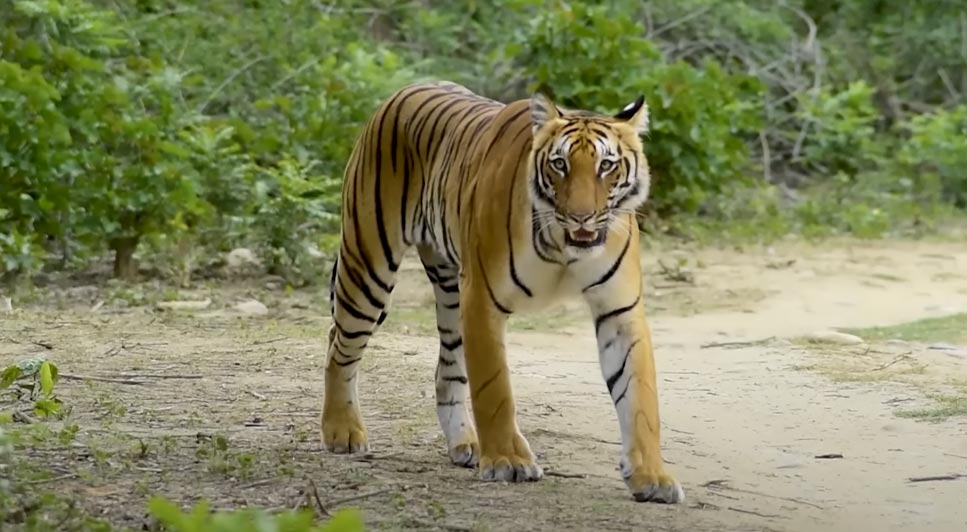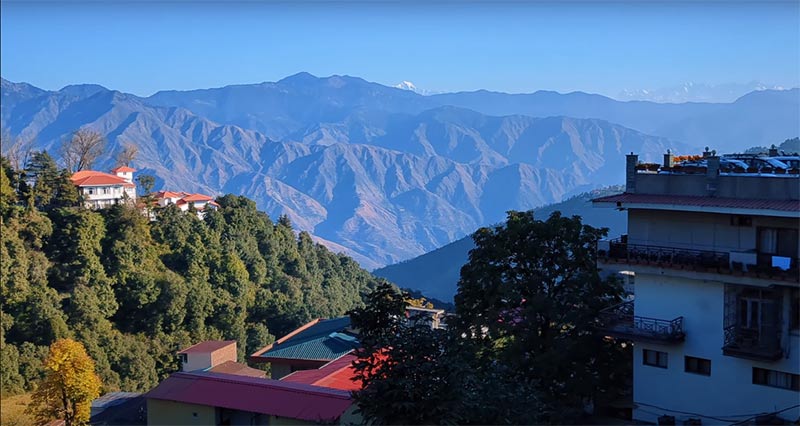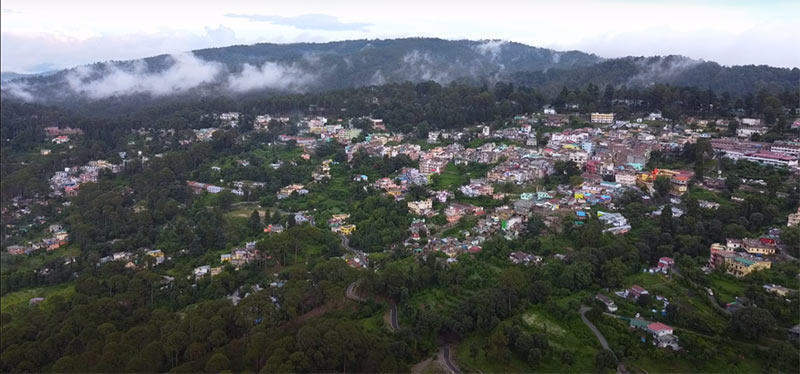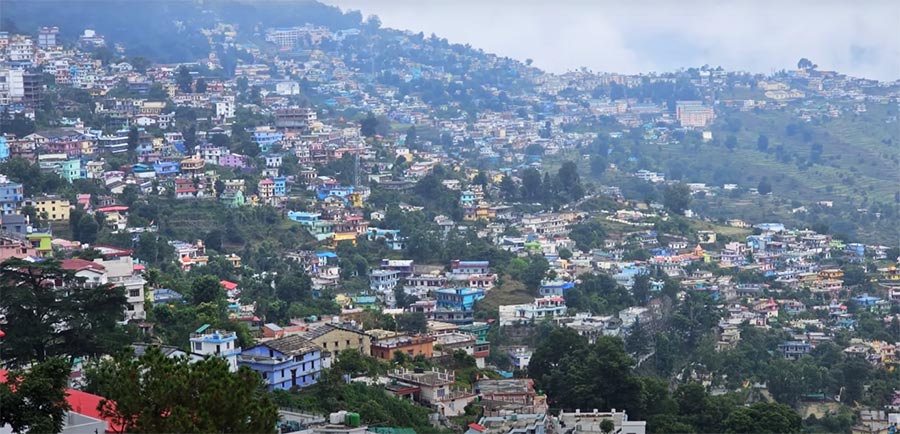Established in 1936, Jim Corbett National Park holds the distinction of being India’s inaugural national park. Named in honor of the renowned naturalist and conservationist Jim Corbett, it is situated at the foothills of the Himalayas near the popular hill-station of Nainital. This beautiful park is particularly famed for hosting a significant population of tigers, the highest among all Indian national parks.

Covering an expansive area of 1318.54 sq km, with 520 sq km as the main region and the rest designated as a buffer, the park spans the picturesque landscapes of Pauri Garhwal, Almora, and Nainital.
Embarking on a jeep safari into the dense forest to observe wild animals in their natural habitat is a must-have experience. Lucky visitors might even catch a glimpse of a tiger. During the safari, enjoy the captivating views of lush green forests, intersected by streams, rivers, and occasional waterfalls.
For those seeking a more immersive experience, accommodations are available inside the park for overnight stays, providing a once-in-a-lifetime opportunity to be surrounded by the park’s natural beauty.
What is the optimal time to visit Jim Corbett?
The primary reason to visit a national park is to witness its diverse wildlife. These parks are often located in remote, forested areas, providing a chance to encounter animals like tigers or lions. However, many safaris can be disappointing due to factors such as extreme heat and not spotting the desired animals.
Wildlife operates on their schedule, but their habits are well-documented, offering insights into the best times for animal sightings. Weather plays a crucial role, making the timing of your visit to Jim Corbett National Park dependent on the climate.
Jim Corbett experiences three seasons—monsoon, winter, and summer—each transforming the park’s colors and landscapes. During the monsoon, from June to September, heavy rainfall makes many zones inaccessible, leading to the park’s closure. Animals seek shelter, but the vibrant greenery compensates for the limited wildlife sightings.
Winter, spanning from December to March, is considered the best time to visit. The forest is lush, animals are active, and the weather is pleasant, increasing the chances of spotting a Royal Bengal Tiger. Winter mornings are particularly favorable for wildlife encounters.
Summer, from April to early June, sees higher temperatures, reaching up to 40 °C. Despite the heat, this period is popular among Indian families due to school holidays. The park organizes summer camps, educational programs, yoga sessions, and other activities for a holistic experience. Morning safaris are recommended to escape the scorching heat.
While summer is busy, it offers a chance to enjoy the wilderness by staying at one of the rest lodges within the park. These lodges enhance the wildlife safari experience. The park is functional from November to May, and planning ahead can help secure the best deals for a memorable trip. Travel experts like SOTC offer comprehensive packages covering travel, stay, and sightseeing, ensuring an unforgettable holiday at Jim Corbett National Park.
Groups with more than 15 people can enjoy the Canter Safari. If you prefer riding on a larger animal, like an elephant, Elephant Safari is also available in Corbett Park.
Popular Tourist Spot near Jim Corbett Park
There are popular tourist spots near Jim Corbett National Park. If you’re visiting, make sure to check them out too.
Corbett Waterfall
Standing at a height of 66 feet, Corbett Waterfall is a must-visit attraction in Jim Corbett. Accessible via a short hike, this enchanting location becomes particularly captivating on full-moon nights, leaving visitors mesmerized. Surrounded by lush forests, the waterfall offers a tranquil setting.
Consider camping or organizing a picnic near Corbett Waterfall to relax after a jungle safari. It’s a renowned spot within the National Park, ensuring a memorable experience for those who explore this beautiful area.
Garjia Devi Temple
Garjia Devi Temple is a significant religious site, a large rock situated in the Kosi River, named after the deity Garjia. Accessible by climbing a few flights of stairs, this temple is a renowned destination in Jim Corbett, drawing devotees from around the world. Many couples also choose to seek the blessings of Garjia Devi here.
If you happen to visit Jim Corbett Park during the Karthik Poornima celebration in November each year, you have the opportunity to attend the fair held at this temple.
Corbett Museum
The Corbett Museum in Kaladhungi was once the heritage bungalow of Jim Corbett, a hunter turned conservationist. It’s a place of historical significance and is considered a must-visit tourist spot in Jim Corbett. Visitors can explore the life and achievements of this renowned conservationist.
The museum houses Jim Corbett’s personal belongings, letters, and a collection of photographs and antiques. It provides an insightful journey into his life. It’s not only an opportunity for self-discovery but also a chance for children to learn about the individual after whom the entire National Park is named.
Sitabani Temple
The Sitabani Temple is dedicated to Sita, making it an ideal destination for those seeking religious sites in Jim Corbett. According to the Hindu epic Ramayana, Sita spent some days in seclusion during the Agnipariksha phase.
Additionally, the area is renowned for a nearby flowing river that attracts many tourists. The tranquil riverbank provides a delightful spot to rest after a tiresome safari tour.
Kalagarh Dam
Established in 1974, the the Kalagarh Dam, also known as Ramganga Dam, plays a vital role in the Ramganga Multipurpose project, aiming to provide irrigation and hydroelectricity to the nearby areas. Situated within the boundaries of Jim Corbett National Park, the dam has become a popular attraction for tourists exploring the park.
This embankment dam, located on the banks of the Ramganga River, also serves as a source of electricity for Jim Corbett National Park. The dam is home to numerous migratory birds, making it a perfect spot for ornithologists, especially during the winter months.
Beyond its functional aspects, Kalagarh Dam is an ideal destination for family picnics and gatherings with friends. A visit to the dam offers a serene escape from the daily hustle, immersing you in the peaceful surroundings of the dam and its natural landscape.
KOSI River
The Kosi River runs along the eastern border of Jim Corbett National Park. Starting from Mohan, it passes through Dhikuli before reaching Ramnagar, a small town in Nainital. The river is a captivating tourist destination, surrounded by lush green forests. It attracts wildlife, creating an adventurous ambiance as animals gather by the riverside for water. Kosi is a tributary of Ramganga, a crucial source of drinking water in the area.
Originating from Dharapani Dhar at an elevation of 2500 meters in the Baramandal region of Almora district, Uttarakhand, the river gracefully flows through the verdant valleys of the hill district before merging into the Terai region of Uttar Pradesh. Locally known as the Kosila, the water resources of the Kosi River contribute to the rich vegetation and farmland of the Kumaun region, sustaining the wildlife and forests of Jim Corbett National Park.
The riverbed of Kosi is lined with boulders, and its flow can be unpredictable. During the monsoon, the river flows vigorously, making it a marvelous tourist destination. Once the monsoon subsides, the water becomes calm and pristine. The riverside offers a serene environment for sunbathing, leisurely strolls, and birdwatching. Overall, it’s a perfect place for a nature-centric vacation.
Virgin Falls of Chukhan
This waterfall may be small in size, but it’s truly magnificent. With a height of approximately 68 feet, it is set against the backdrop of a scenic, lush green forest. You can enjoy a refreshing nature bath in the waterfall.
Hanuman Dham Mandir, Choi
A serene and peaceful destination for devotees of Lord Hanuman, this unique and expansive temple is the first of its kind. It is dedicated to Lord Hanuman, featuring various depictions not only from the Ramayana but also from older incarnations.
The vastness of the Hanuman Dham temple, coupled with its serene and positive vibes, makes it a must-visit—whether you choose to explore it alone or with family and friends.
Where to stay in Jim Corbett?
Mostly main gates of Corbett Tiger Reserve are located near Ramnagar, and there is a place called Dhikuli where you can find all types of hotels and resorts. Apart from this, Kashipur, Ramnagar, Haldwani, and nearby villages have some good resorts. So, you will easily find hotels and resorts within your budget, ranging from luxurious to affordable. Some of the notable resorts in Jim Corbett are as below.
Pagoda Manu Maharani, Dhikuli: Pagoda Manu Maharani is a calm and comfy place in Dhikuli. It’s like a peaceful oasis with natural beauty all around.
Corbett Aroma Havens, Jim Corbett: Corbett Aroma Havens is in Jim Corbett, surrounded by nature. It’s a perfect spot for people who love nature, with lots of greenery and a calm atmosphere.
The De Floresta Resort, Corbett: The De Floresta Resort in Corbett is a wonderful place to stay. It’s a mix of luxury and nature, making your stay memorable and enchanting.
Namah Hotel, Dhikuli: Namah Hotel is tucked away in the beautiful Dhikuli. It’s a comfortable and elegant place, perfect for those who want a relaxing experience.
Hotel Corbett Kingdom, Ramnagar: Hotel Corbett Kingdom is right in the middle of Ramnagar. It welcomes travelers with warmth and offers all the modern amenities for a pleasant stay.
The Baakhli Corbett, Choi: The Baakhli resort Corbett in Choi is like a peaceful retreat surrounded by nature. It gives you a quiet place to relax and enjoy modern comforts.
FAQ about Jim Corbett Park
Jim Corbett National Park was established in 1936, making it India’s first national park. It is named after the renowned naturalist and conservationist Jim Corbett.
Jim Corbett National Park covers an expansive area of 1318.54 sq km, with 520 sq km designated as the main region and the rest as a buffer. It spans the landscapes of Pauri Garhwal, Almora, and Nainital.
The best time to visit is during winter, from December to March, when the weather is pleasant, and wildlife is active. Summer (April to early June) is busy but offers activities like camps and yoga. Monsoon (June to September) leads to park closures due to heavy rainfall.
Visitors can embark on jeep safaris for a chance to spot a variety of wildlife, including tigers. Accommodations inside the park provide an immersive experience, allowing guests to stay surrounded by natural beauty.
Key attractions include Corbett Waterfall, Garjia Devi Temple, Corbett Museum, Sitabani Temple, Kalagarh Dam, Kosi River, Virgin Falls of Chukhan, and Hanuman Dham Mandir in Choi.
Winter is considered the best time due to pleasant weather, lush forests, and increased wildlife activity, enhancing the chances of spotting a Royal Bengal Tiger.
Corbett Waterfall, standing at 66 feet, is a must-visit attraction offering enchanting views. Visitors can camp, have a picnic, and experience the waterfall’s beauty, especially on full-moon nights.
The Corbett Museum in Kaladhungi, the former bungalow of Jim Corbett, displays his personal belongings, letters, photographs, and antiques, providing insights into the life of the renowned conservationist.
The Kosi River, running along the park’s eastern border, attracts wildlife and creates a picturesque ambiance. It serves as a crucial water source and adds to the park’s rich biodiversity.
Although small, the Virgin Falls of Chukhan, with a height of approximately 68 feet, offers a magnificent experience against the backdrop of a lush green forest, providing a refreshing nature bath.
You can discover additional Tourist Destinations by clicking the link below
Tourist places, Uttarakhand



